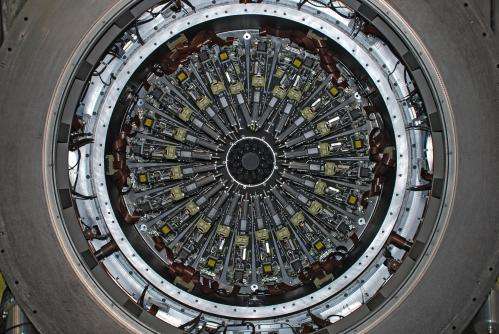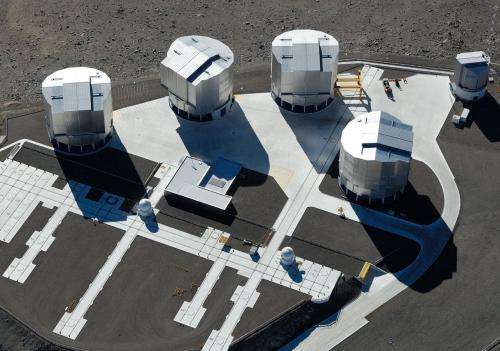UK contributes 24 robotic arms in giant leap forward in near-infrared astronomy

A new high-tech instrument with 24 robotic arms has crossed the Atlantic from Edinburgh to a mountain top in Chile to address in more detail than ever before, some of the key questions surrounding the beginnings of the Universe, stars and galaxies. KMOS (K-Band Multi Object Spectrometer) has been provisionally accepted by the European Southern Observatory (ESO) after it completed final assembly and testing at the UK Astronomy Technology Centre (UK ATC) in Edinburgh. It will now be fitted to one of the four telescopes which make up the European Southern Observatory's Very Large Telescope (ESO-VLT) at Paranal in Chile, providing astronomers with a far quicker solution to uncover details about galaxies and their properties.
What makes KMOS unique is its ability to image many galaxies simultaneously either in a cluster or in isolation but in both cases, still see the individual properties of each single galaxy. Until now, each galaxy has had to be identified individually to obtain that information, a process that takes years. KMOS will be able to see the same amount of detail in just two months.
Each of the 24 cryogenic robotic arms, which have gold plated mirrors on their tips, can be moved into position to pinpoint with extreme accuracy the light coming from distant galaxies.
Dr Michele Cirasuolo is the lead instrument scientist for KMOS at UK ATC. He said: "KMOS represents a pivotal step in our quest to scrutinise the distant Universe. The ability to observe in the near-infrared 24 galaxies simultaneously is an enormous leap forward compared to any other current instrument. KMOS will allow a much faster survey speed…most of the observations done by similar near-infrared spectrographs over the last 10 years could be done in just two months with KMOS."

This novel capability means astronomers will be able to make a detailed study of the mass assembly and star formation in distant, high red-shift galaxies addressing fundamental questions about when these first formed and how they evolve. This ability to observe multiple galaxies at once enables scientists to build up large statistical samples of galaxies at different cosmic epochs necessary to unveil the physical mechanisms that shape their formation and evolution.
KMOS creates this detailed picture using integral field spectroscopy and obtains spectra over a two-dimensional area, covering the entire galaxy. The light from each segment of galaxy (its core, the bulge, the spiral arms and the outer parts) is analysed simultaneously and each can be given physical and chemical properties. Not only therefore, can a complete galaxy be measured, but each individual part too, allowing a comprehensive picture to be built.
"For each of the galaxies, KMOS will give an incredible amount of information. It's not just a picture of a galaxy, but 3D spectroscopy providing the spatially resolved physics and the chemistry and the dynamics. This is crucial to understand how galaxies assemble their mass and shape their structure as a function of cosmic time, up to the formation of the very first galaxies, more than 13 billion years ago" explains Michele Cirasuolo.
The specialised mechanisms inside KMOS have been designed to work in cryogenic conditions below minus two hundred degrees centigrade, which has been a major challenge, but which is necessary to observe distant galaxies at near-infrared wavelengths. This is because, unless cooled, the thermal emission from the instrument itself will swamp the faint signal from the astronomical sources.
Minister for Universities and Science David Willetts said: "It's excellent to see the UK playing a leading role in the development of such a sophisticated piece of technology and overcoming some very complex engineering challenges on the way. This instrument will now take its place on a world leading telescope to help improve our knowledge and understanding of the universe around us."
The instrument is a collaboration of six institutions in Germany and the UK, including STFC's UK Astronomy Technology Centre (UK ATC), Durham University, Oxford University and RAL Space at STFC's Rutherford Appleton Laboratory. The team of internationally respected scientists and engineers at UK ATC played a major role in the KMOS project, being responsible, amongst others, for the construction of the cryostat, the 24 robotic pick-off arms, the cable co-rotator and the final assembly and test of the complete instrument. RAL Space applied their cryogenic lens mounting technology in the three camera barrels they provided for spectrographs in KMOS. Durham University has the PI of the entire project and produced the complex system of more than 1000 mirrors in the integral field unit. Oxford University provided the design and assembly of the three spectrographs in KMOS.
Each incredibly powerful unit telescope on the VLT contains a mirror eight metres in diameter. It is onto the VLT Unit 1 telescope, Antu that the new KMOS equipment will be fitted.
Provided by Science and Technology Facilities Council



















